

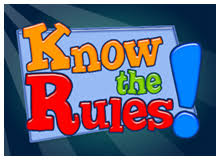

Welcome to the Para Hills Bowling Club,
Lawn Bowls is a Sport which can be played by everyone within the Community.
Your Gender, Age, Physical Ability and Capabilities are no Barriers to having a Go!
It is a sport that takes just a short time to learn and the rest of your bowling career to master. It is a Friendly, Non Contact and very Sociable Game to play and a great way to be physically active.
As a New Bowler you will find within this guide a basic introduction to the sport, however for more information ask the Club Coach, Manage Committee Member more information.
Please note that the information in this guide is general in nature only and cannot be relied upon as professional advice. Use this as a guide only and obtain your own independent and professional advice where appropriate.
Important Information
1 – LAWS OF THE SPORT OF BOWLS
(Crystal Mark Version 3.1)
It is advisable that every bowler obtains a copy of the publication titled Laws of the Sport of Bowls and becomes familiar with the rules of your sport. Copies are available at the Club Bar.

Bowls Australia (BA), in consultation with the National Officiating Advisory Group (NOAG) and World Bowls (WB), has launched the latest edition of the Laws of the Sport (Crystal Mark Version 3.1). Further information, including when the Laws of the Sport of Bowls are reviewed and a link to enable the downloading of the latest version (Crystal Mark version 3.1) can be found here
In its introduction it states;
“No laws governing a sport can cope with every situation, and the laws governing the sport of bowls are no exception. Unusual situations not covered within the laws can often arise.”
This is worth bearing in mind when you read through this guide, as rules and situations may differ slightly depending on the local environment.
Of course there are other sources from which useful information may be obtained. The websites of Bowls Australia , Bowls SA and the Metropolitan Bowls Association are three valuable sources of information.
Bowls Australia is the national sporting organisation responsible for the leadership, development and management of lawn bowls in Australia.
Bowls SA is the governing body of Lawn Bowls in South Australia and one of the larger not-for-profit organisations in the State. Bowls SA has 220 clubs in the metropolitan and country areas of South Australia and over 17,000 registered members.

However in 2017 the Metropolitan Bowls Association (MBA) became the primary organisation to advance and administer the game of bowls in the Adelaide Metropolitan Area of South Australia. The role of the MBA is to provide effective, transparent and professional governance of the metropolitan bowls competitions. The Executive Committee is tasked with determining directions, policies and conditions of play, acting in accordance with the Objects and Purposes of the Metropolitan Bowls Association Constitution, for the collective benefit of all metropolitan Member Clubs and Members and for the future of the sport. The Para Hills Bowling Club is one club that falls under the umbrella of the MBA.
The MBA distributes an Events Calendar that outlines when the Metropolitan Lawn Bowls Pennant Season commences and concludes. The calendar, which applies to the Para Hills Bowling Club, is the Metropolitan Bowls Events Calendar. You can find a copy of the Metropolitan Bowls Events Calendar for the 2023-2024 bowls season here.
In regard to the conditions of play in the metropolitan area the MBA has promulgated the Rules And Conditions of Play for the 2023-2024 pennant season, a copy of which can be found here. It is essential that bowlers representing the Para Hills Bowling Club become conversant with this publication.
The reason for this is because it is imperative members and our Club, comply with it’s administrative conditions. A failure to comply with these conditions may result in a fine being imposed upon our Club or a Club Member. Bowls SA has published a Fines, Penalties and Lodgement Fees Schedule, the objective of which is to serve as an incentive for Member Clubs and Members to comply with the administrative requirements of Bowls SA, Bowls Australia and government legislation. To help ensure compliance and avoid incurring a fine, it is recommended you view the Fines, Penalties and Lodgement Fees Schedule.
In addition in July 2017 Bowls Australia approved the Instantaneous Penalties Policy stating; “Bowls Australia believes in a fair and equitable competition and will do everything in its power to ensure that all players participate within the Laws of the Sport of Bowls.” In May 2019 the Bowls SA Officiating Advisory Group and the Bowls SA Board adopted the Bowls Australia Instantaneous Penalties Policy. Bowls SA have advised that Clubs and Associations are encouraged to adopt this policy for their own events. A copy of the Instantaneous Penalties Policy may be found here.
2 – ABOUT THE CLUB
Induction
On joining the Para Hills Bowling Club you will be invited to undertake an Induction of New Member Session. A senior member will show you around the entire club premises explaining, amongst other things, where particular items are located, e.g. first aid kits and who is responsible for certain areas of the club etc.
Volunteers

Clubs and their volunteers are the backbone of your sport. You will find many volunteers within your Club who give their time to carry out a wide range of tasks so that members and visitors can enjoy the game and club facilities. Our volunteers include members of the Board of Management, those members that maintain the greens and those serving behind the bar, to name but a few. Please be appreciative of their efforts and if there is any way you can help when you are not “on the green”, undoubtedly your club will be pleased to welcome you on board as a volunteer.
Club Administration
Your club is governed primarily by The Para Hills Bowling Club Constitution. The objects of your club, as stated in the Para Hills Bowling Club Constitution, are;
“The objects of The Club shall be:-
1.3.1. to maintain and conduct a Club of non-political character, culture and gender impartiality and to provide clubrooms, bowling greens and other conveniences for the use and recreation of Club and community members;
1.3.2. to promote such other objects as the members shall determine but always to have in mind the advancement and best interests of the game of bowls and sportsmanship;
1.3.3. to affiliate with Bowls SA and any other organization that may be desirable in the pursuit of these objects;
1.3.4. to do all such things necessary to the attainment of the above objects.”
It is strongly recommended you familiarise yourself with the Para Hills Bowling Club Constitution.
Your club is managed by the Board of Management. You will find details of the Board of Management, other Committees and further information about your clubs administration here.
Our Bowling Greens.

Lawn Bowls in Australia is played on a flat surface area composed of grass or some other artificial or synthetic surface called ‘the green’. This flat surface is divided into playing areas called ‘rinks’. The Para Hills Bowling Club has 1 Grass Green(B) and 2 Synthetic Greens(A and C). The greens are surrounded by a small ditch to catch any bowls that leave the green during a game, and a bank upon which markers indicate the corners and centre lines of each rink.
Bowling green’s require maintenance and many hours are put in by volunteers to keep the playing surface on our greens in the best possible condition. As such it is essential that the correct footwear is worn when on the greens and bowlers use a good delivery of their bowls to prevent damage to the greens. Never drop your bowls onto the green or “dump” your bowls when bowling as this will damage the green.
The bowling greens are your clubs most valuable asset. Bowls SA is conscious of its responsibility to assist Member Clubs with the preservation of their most valuable asset. It has provided a direction outlining the process to follow when a member or visitor is observed as potentially causing undue damage to a bowling green. The Bowls SA Damage to Greens Policy and the No Smoking Policy are policies of which you should be aware. Most Bowling Clubs are now smoking free or otherwise have designated areas for smokers, such as your club.
Fast and Slow Greens
What does it mean when it is said that a green is fast or slow? A faster green means that the bowl takes longer to reach the jack usually somewhere between 14 to 19 seconds. On a fast green a bowl must be rolled to take more grass, that is, it is rolled in a wider curve. On the other hand, on slower greens the bowl takes less time to reach the jack, say 10 – 14 seconds, and should be rolled to take much less grass, that is in a slight curve. To become more familiar with fast and slow greens you may wish to view Green Speeds
3 – ABOUT YOU

As with any sport it is generally believed you will only get out of lawn bowls what you put into it. Your approach should be one of enthusiasm, friendliness and tolerance.
Your club is only as good as the members that are within it, so please play your part in making your club one of the best there is and somewhere that you and other new players will wish to join and remain with for many years to come.
Always be on time for any scheduled game. Switch off your mobile phone. Do not drink alcohol excessively, use offensive language or gestures. Friendly and polite sporting acts towards team mates and opponents are appreciated and reciprocated. It is these little extras that make the game of lawn bowls so appealing. Your Club has a Code of Conduct. It is strongly suggested that you become familiar with it.
Dress

Your dress should be styled for comfort and protection from the elements. Your club encourages casual dress for practice sessions and social bowls events that are usually held at your club during the winter months.
Your club members wear their club colours for representative matches and internal tournament championships only. Your club colours brighten up the image of your club and the sport generally, making it more attractive to all age groups.
Personal safety

Because of the extreme weather conditions in South Australia, it is imperative that members provide themselves with adequate protection by dressing appropriately and applying sun screen to areas of the skin that are exposed to the sun, particularly when temperatures are high.
Regular fluid intake during bowls is very important. Although lawn bowls is not extremely physically demanding, the body will still lose fluid and this should be replaced. Water is the best replacement however sport drinks or soft drinks are acceptable. Although alcohol is sometimes consumed, in reality it will dehydrate you.

Bowls SA is conscious of its responsibility to provide direction to its Member Clubs, Sections, Associations and Regions in relation to the conduct of the game of bowls under extreme weather conditions, in particular prolonged heat. For this reason Bowls SA has developed the Heat & Inclement Weather Policy. It is essential bowlers representing the Para Hills Bowling Club become familiar with this policy.

At times inclement weather conditions may be encountered. Below is a summary from the Bowls SA Heat & Inclement Weather Policy in regards to Lightning.
Lightning can occur without other typical storm characteristics (i.e. thunder, rain and wind) being
present. Bowls SA is committed to ensuring that all players, officials, administrators and spectators are safe during lightning activity. When lightning is sighted by the Event Manager or Umpire of the Day, play will be suspended and all players will be required to leave the green immediately and move to a safe structure.
No place is absolutely safe from lightning strikes, but the Event Manager or Umpire of the Day is to ensure that all parties are made aware of the location’s safe areas.
SAFER areas include:
o Enclosed vehicles with windows closed (car, bus). Do not touch metal parts.
o Substantial enclosed buildings
o Low ground, sheltering in clumps of low bushes
o Trees of uniform height i.e. forest
UNSAFE areas include:
o High ground
o Open ground
o Water
o Isolated or tall trees
o Near outdoor metal structures such as shade shelters, fences, flag poles, gates, seats, steps, hand rails, boundary pegs
o Equipment such as Bowling Arms, bowls lifters, bowls rakes, umbrella, etc.
When the Event Manager or Umpire of the Day deems it safe to return to the green, play should resume as per the Laws of the Sport of Bowls, Law 32.
Lawn bowls is not a dangerous sport however it always pays to be careful as some injuries can occur. The following basic safety warnings are offered in order to prevent possible injury;
- Take care when stopping a speeding bowl with your hands or feet.
- Never walk backwards on the green to avoid stepping on bowls.
- Never deliver the bowl at full speed unless directed to do so by the Skip and other bowlers have been warned.
- Be careful not to drop bowls onto your, or any other bowlers feet.
- Be careful when stepping on and off the green.
Health Benefits
There are certain health benefits associated with participating in lawn bowls. These may include;
- an improved level of fitness.
- increased confidence and coordination.
- enhanced mental well-being.
- enhanced social and community connectivity and an increased level of personal support.
Bowlers Arms and other artificial devices
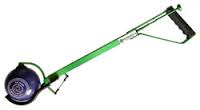
Bowls Australia advise that “a bowlers arm is designed to assist a bowler who cannot continue to bowl without the aid of the artificial device and can be used in any competition within Australia. Typically they are used where a person has hip/knee complaints which restrict their ability to bend down to deliver the bowl correctly.”
There are three types of bowlers arms for use in Australia. Visit this Bowls Australia page to learn more about approved bowlers arms .
In South Australia there exists the Bowling Arm Players Association of South Australia. The Associations purpose is to provide support to bowlers that use mechanical bowling arms. For further information please visit the website of the Bowling Arm Players Association of South Australia.
Bowls Australia has formulated a policy covering artificial devices that are used on the bowling green, including wheelchairs, walking frames and bowlers arms. For further information you may wish to visit the Bowls Australia Artificial Devices Policy.
4 – STARTING OUT

It is essential that you wear a pair of flat soled shoes and not shoes with ripples or heels. This is for the protection of the greens at all clubs. A failure to wear the correct footwear may prevent you from participating. Bowls Australia has provided a definitive list of the shoes currently approved for use in Australia for the sport of lawn bowls. Before purchasing your bowls shoes it may be beneficial to consult the Bowls Australia Footwear Page.
Choice of Bowls
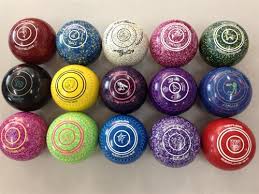
Once you have decided to take up the game of lawn bowls, one of your first decisions will be choosing a set of bowls. Your club has some bowls readily available for you to use initially. It is important to try several sets of bowls to find the bowl that suits you before you make a purchase. Your club notice boards are usually a good place to find second hand bowls available for sale. This will be a significantly cheaper option. Consult other bowlers and ask to try their bowls. They may just have a set of bowls that suit you.
Bowls come in sets of four and each is identical. The bias of different sets can vary, but every set of bowls must meet minimum standards for bias.
Because of varying sizes of the human hand, bowls come in different sizes. It is suggested that one way to get the right size, shape and weight for you is to wrap both of your hands around the widest running surface of the bowl so that your middle fingers touch at the top and if your thumbs touch at the bottom, then that is probably your size. If, when bowling, the bowl slips out of your hand or the bowl drops onto the grass, then you may need to move down in size until you are comfortably in control of your bowls.
Today there is so many bowls to choose from – different sizes, weights, makes and colours, so be sure to thoroughly research your options and take sufficient time in choosing the right bowls for you. Only make a purchase when you are satisfied you have found the bowls that are suitable for you to use on the green.
5 – ABOUT THE BOWLS
What makes the bowl turn? Many people believe one side of a bowl is more heavily weighted than the other. However it is the shape of the bowl that makes it turn, rather than anything to do with weight. This is known as ‘bias’.
The curved path taken by the bowl is always towards the side on which the smaller disc is displayed. This only happens when the bowl begins to slow down.
The point at which the bowl begins to turn is known as the ‘shoulder’ and this will vary according to the distance, or length, that the jack is from the mat. A simple guide is that the shoulder is roughly two thirds of the distance the bowl has to run to arrive at its objective.
Date Stamp on the Bowls
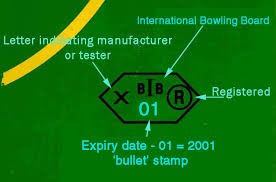
World Bowls requires that licensed manufacturers and licensed testers put the registered ‘World Bowls Stamp’ either on the small end or between the inner and outer rings of the bowl. This stamp validates that the bowl complies with all the regulations and specifications of World Bowls. Introduced in 2002 the stamp is now used on all new and re-tested bowls. The stamp is a requirement for the bowls to be valid for use in major competitions under the control of World Bowls or any Member National Authority.
You may wish to see How a Lawn Bowl is Made
Bowls manufacturers
There are a number of bowls manufacturers. Here are just some you can locate online.
Henselite: http://www.henselite.com.au
Drakes Pride: http://www.drakespride.com.au
Aero: http://aerobowls.com
6 – INITIAL SESSION
As a new bowler you will be encouraged to take part in an initial introductory session with a qualified coach or an experienced bowler at your club.
Delivering the Jack (sometimes referred to as the “Kitty”)
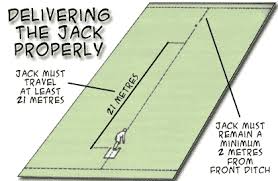
The jack comes in two colours, either white or yellow. Usually you will be given a jack and asked to stand on the mat. You will be asked to roll the jack towards your coach (or some other nominated spot) who will usually be standing some distance in front of you. The natural movement in rolling a jack is what the coach uses in helping you to establish a delivery action. It also enables the coach to build on the good points in your natural delivery and to encourage any necessary correction in stance, timing and rhythm etc.
Usually the coach will vary the places where they stand in relation to the mat, so that you have to vary your stance on the mat, and change the position of your feet, to accommodate the new angles of delivery. Once a smooth and easy delivery action is evident, then you are ready to repeat it – this time using a bowl.
Position on the mat and stance
Before delivery of your bowl you should stand with at least one foot fully on the mat. Face out to the chosen side of the mat, depending on whether you have elected to bowl forehand or backhand, in order that the bowl can be delivered to allow the bias to take effect.
It is usually recommended that you stand with your feet parallel and slightly apart, pointing along the line on which the bowl is going to travel. Your stance should be well balanced and comfortable. The bowl should be held for both comfort and control, and on a line just outside the right or left hip, depending on whether you are right or left handed, so allowing an unimpeded backswing. Your eyes should be looking along the delivery line and not at the jack.
Delivering the Bowl
Every bowler’s delivery action is as unique as their fingerprints – which mean that no two bowler’s deliveries will be identical. However in general, three criteria need to be satisfied:
- That the delivery action is comfortable; can be repeated precisely for long periods of play, and does not produce unnecessary strain.
- That it is effective.
- That it conforms to the Laws of the Sport of Bowls.
The coach will advise you on these three points when encouraging you to develop your own bowling action. He / She will also advise you on the best way to hold the bowl so it is held comfortably and confidently in your hand.
If the bowl is delivered smoothly, the coach will make no further adjustments. If this is not the case then a small adjustment in grip, or perhaps the size of bowls being used, may be necessary.
Before delivering the bowls an aiming point should be selected. This is a point to which your bowl should be aimed, to enable it to curve and finish near the jack. The aiming point will differ from bowl to bowl due to their varying construction. Rather than provide a detailed explanation please view Finding Your Aiming Points.
When delivering the bowl some players prefer to combine the movement of a forward stride simultaneously with their back swing. Others place the forward foot a walking pace in front of and parallel to the back foot before beginning the back swing. This is a matter of personal preference.
On completion of the back swing you must now consider the forward swing, at the same time bending knees so that at the moment of release the hand holding the bowl is as close to the bowling surface as possible. This ensures the bowl is delivered smoothly. Releasing the bowl to early will cause it to bounce and generally it will lose speed and its intended trajectory.
The right-handed player steps forward with the left foot and at the same time swings back the right arm holding the bowl. The body is lowered down and the left hand placed on the left knee for support, as the right arm comes forward to deliver the bowl on the green when the body has dipped to the lowest point. For the left handed player, of course, the procedure is reversed.
Never “Dump” a bowl as shown in the picture below.
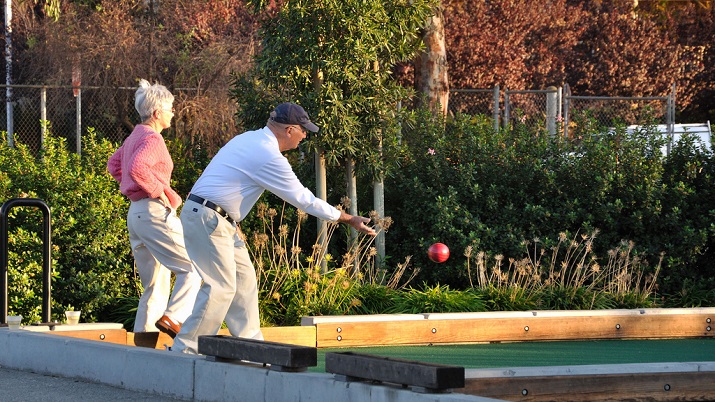
Bowling greens are quite delicate areas and it is easy to cause damage by throwing or dropping (referred to as dumping) a bowl. Although different players have different delivery styles, it is essential to make sure your technique does not cause any damage to the green. If it does then seek advice from the club coach as undoubtedly your delivery technique requires improvement. You should never drop bowls onto the green under any circumstances. If you cannot bend down and bowl correctly then you should consider using a bowlers arm.
Position of the feet
At the moment of delivery, the player should have all or part of one foot on or above the mat. If the player is using an approved wheelchair, at the moment of delivery the player should have all or part of one wheel on the mat. Any player who does not adhere to this may be found to be ‘foot-faulting’.
Follow through
As in other sports, a smooth follow through is most important. The bowling hand should be brought forward parallel with the body throughout its movement, and continue, even after the bowl has been delivered.
To learn more about correctly delivering your bowl, you may wish to view Delivery
Concentration
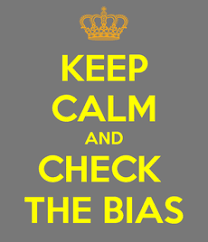
This is an essential requirement for any bowler aspiring to an improved standard. So many bowlers allow outside factors to interfere with their concentration that it is probably the greatest single reason why they fail to improve.
It is often noticeable that even top players will play a good shot when attempting to convert or save, but it is surprising how many times the same players will fail to add to the score when they have plenty of room to draw another shot. This is due mainly to a lack of concentration. A bowler must try to maintain 100% concentration at all times when playing. Nothing less is acceptable.
Practice
After you have been taught the basic skills, it is crucial that you practice as much as possible. The main and most used shot in the game is the draw shot. After mastering the draw shot, you can progress to become skilled at the techniques used in playing further shots. Regular practice is essential.
7 – FORMATS OF THE GAME OF BOWLS
The most common formats of the game of lawn bowls are:
Singles: Two players with four bowls each.
Pairs: Two teams of two with four bowls each.
Triples: Two teams of three with three bowls each.
Fours: Two teams of four with two bowls each.
Generally the winner is the one, or the team, with the highest score usually after 21 ends. However this may differ from club to club depending on location, type of game and local rules.
In team games each member has a particular role to play. To illustrate team games, the following gives a brief outline of the duties of each player in a ‘fours’ game:
Lead: The Lead is the first to bowl. The Lead places the mat, delivers the jack and after the Skip has centred it, attempts to bowl as close as possible to the jack.
Second: The Seconds bowl after each of the Leads have played their bowls. The Second may be asked to play a variety of different shots by their skip depending on what the Leads and the opposing Second have done. Also Seconds are responsible for entering the names of all players of both teams on the score card, recording on the score card all shots scored for and against their team as each end is completed and comparing the score card with that of the opposing Second. These responsibilities may differ from club to club or from game to game depending on the local rules and circumstances on the day. Should the responsibilities differ both Skips need to be in agreement.
Third: The Third may be called upon to play different shots in order to score more, or to place bowls tactically to protect an advantage. In addition the Third is also responsible for advising the Skip of the state of the head when it is the Skips turn to bowl and/or when requested. The Third is also required to measure to determine the winning bowls when required and agreeing the number of winning shots with the opposing Third at the completion of each end.
Skip: The Skip has overall responsibility for the rink and should be an experienced and capable player to offer assistance to new bowlers. The Skip’s duties include directing the development of each end and settling any disputed points with the opposing Skip especially when there is no umpire present. At the end of the game, the Skip is responsible for signing the score card recording on it the time the game finished.
8 – PLAYING THE GAME
Lawn bowls can be played as singles, pairs, triples and four player teams. It is played on a synthetic or flat grass surface called the ‘green’. The length of the green in the direction of play should be between 31 metres and 40 metres. The green is divided into sections called ‘rinks’ which should be between a minimum of 4.3 metres and a maximum of 5.8 metres wide. As previously mentioned, surrounding the green is a ditch, and a bank where markers indicate the boundaries and centre lines of each rink.
Each game is split into individual ends. Players deliver their bowls alternately from the mat at one end on the centre line of the rink. After the mat has been laid on the green, the jack is delivered toward the other end. The jack is perfectly round, much smaller than a bowl and as previously mentioned is either yellow or white.
At the start of each end the Lead will place the mat on the centre line of the rink and deliver the jack. The jack is then put on the centre line at the other end of the rink by the Skip. The jack must be a minimum of 23 metres from the mat at the start of the end, or 21 metres depending on the game and local rules.
Players from each team then deliver their bowls alternately from the mat. The aim is to get one or more of their bowls closer to the jack than the closest bowl of the opposition bowler. One point is scored for each counting bowl. For example if your two bowls finish closer to the jack than any of your opponents bowls, then you have scored two points.
After playing all the bowls in one direction, and agreeing to the score, the following end is played back down the rink in the opposite direction. The winner of the previous end will cast the jack first.
The art of bowls is being able to deliver (draw) bowls consistently close to the jack unless directed by the Skip to do otherwise.
After the completion of an end, the number of a team’s bowls which have finished closest to the jack are counted. One shot is allowed for each bowl nearer to the jack than the nearest bowl of the opposition. For example, if your team has three bowls closer to the jack than your opponent’s nearest bowl then you will score three for that end. Any bowls forming the head must not be disturbed or removed until the score has been agreed to by the Thirds of both sides.
The winning team is usually the first to reach the highest score, or in some cases a designated score, generally after 21 ends in most games. There are of course other games played that may have a different set of rules and scoring process. Make sure you check the rules and the scoring process before commencing your game.
Competitive bowls
The game of lawn bowls is a splendid medium for limited exercise, also social and competitive interaction. The good sportsmanship of a bowler is always to the fore, and this is an essential requirement of all who play.
Newcomers to the game are strongly advised to play as many competitive games as possible to improve their skills, develop knowledge of the game and enjoy the opportunity to make new friends.
Finally, may you have many years of bowling enjoyment at the Para Hills Bowling Club, enjoy the facilities and make many lifelong friends along the way.
9 – GLOSSARY OF BOWLING TERMS
Back bowl: A bowl that has come to rest behind the jack or the main body of bowls in the head.
Backhand: When (for a right handed player) the bowl is delivered so the curve of the bowl is from left to right towards its objective.
Bank: The outer wall of the ditch which surrounds the green, and which is above the playing surface.
Be up: An instruction from the skip to bowl longer and not be short of the jack.
Bias: That which is inbuilt into the bowl and causes the bowl to travel in a curve.
Blocker: A bowl that stops an opponent from reaching the desired target.
Centre line: A line that runs length wise down the centre of the rink.
Counter: Any bowl which contributes to the score at the completion of the end. Some refer to it as being ‘in the count’.
Dead bowl: A bowl which comes to rest in the ditch, or is knocked into the ditch and is not a toucher, or a bowl that comes to rest outside the confines of the rink, either on its original course or by being knocked there, or comes to rest less than 14 metres, as measured in a straight line, from the mat, or is illegally delivered. A dead bowl is removed from play.
Dead end: An end is declared ‘dead’ if the jack leaves the confines of the rink or comes to rest less than 20 metres, as measured in a straight line, from the mat. No score is recorded and the end is played again.
Delivery: The moment the bowl leaves the bowler’s hand.’
Ditch: The green is surrounded by a depression whose edge marks the boundary of the playing surface. Measurements of the ditch need to conform to the laws of the game.
Draw: A bowl delivered at the correct weight, and with correct line, to arrive exactly at its objective.
Drive: A bowl delivered with enough weight to alter the head, remove the jack or a specific bowl. It is not necessarily a bowl that is bowled as hard as the bowler can deliver the bowl.
Dumping: Dumping a bowl is when a bowl is thrown or dropped rather than being delivered correctly. Bowling greens are delicate areas, and it’s easy to cause damage by throwing or dropping a bowl. Don’t “dump” a bowl.
End: The sequence of play beginning with the placing of the mat and ending with the coming to rest of the last player’s bowl, after all bowlers have delivered their bowls in the same direction.
Fast green: Usually a dry and closely cut surface, which offers little resistance to the progress of the bowl, meaning it takes longer time to reach its objective.
Fluke: A shot that ends up being successful despite being off-target.
Follow through: A natural movement forward of the delivery arm following the line of the bowl.
Foot fault: The player should have at least part of one foot on or above the mat at the moment they deliver the jack or bowl. A failure to do so will result in a ‘foot fault’.
Forehand: When (for the right handed player) the bowl is delivered so that the curve of the bowl is from the right to left towards its objective.
Fours: A group of four players against another four, each bowling two bowls.
Grass: The curved line that the bowl must travel from the mat to its objective. Many new bowlers will be advised to take more or less ‘grass’ when bowling to help them to get closer to the jack
Green: The total playing surface, the measurements of which are laid down by the laws of bowls.
Head: The jack and any bowls which have come to rest within the boundaries of the rink of play and are not dead.
Heavy bowl: Where a bowl has been delivered with too much pace and comes to rest beyond its objective.
Holding shot: The bowler, or team, with their bowl closest to the jack.
Jack: The round white ball towards which play is directed. The jack may also be referred to as the ‘kitty’. The jack is not biased and therefore will run in a straight line.
Live bowl: Any bowl that comes to rest within the confines of the rink or any toucher that comes to rest in the ditch.
Mat: The rectangular shaped mat from which the bowler must deliver the jack and/or bowl.
Mat line: The edge of the mat nearest to the front ditch.
Mark: The marking of a toucher with chalk.
Marker: A person who in a game of singles will mark all touchers, centre the jack, measure disputed shots when asked by the players and keep score.
Measure: A device used to determine which bowl is nearest the jack.
Measuring: The process of determining which bowl is nearest the jack.
Narrow bowl: Where a player has not allowed enough green (or grass) for their intended shot.
Pairs: Two players against two, each using four bowls.
Penalty: A penalty may be imposed by an umpire where, for example, a player has foot faulted in delivering a bowl and the umpire could declare the bowl to be ‘dead’ and it is removed from the end.
Promoting a bowl: Pushing up one of your bowls, or your team’s bowls, to a better position.
Rink: The rectangular area of the green between 4.3 metres and 5.8 metres wide on which play takes place.
Rub Off: A bowl, which during its running course, comes into light contact with another so that the line of direction can be affected.
Second bowl: The bowl which finishes closest to the jack other than the shot bowl. Sometimes called second shot or second wood
Short bowl: Where a bowl has not been delivered with sufficient pace to reach its objective.
Short jack: Near to or the shortest distance allowed from the front edge of the mat to the jack.
Shot bowl: The bowl closest to the jack.
Shoulder of the green: The point on the green where the bowl begins to curve inwards towards its objective.
Skip: The player who captains a game of fours, triples, or pairs. The last to bowl and responsible for dictating the tactics of the game.
Slow (or Heavy) green: Where the surface offers greater resistance to the progress of the bowl.
Speed of the green: The number of seconds taken by a bowl from its delivery to the moment it comes to rest at approximately 27 metres from the mat line. The higher the number of seconds taken, the faster the pace of the green.
Stance: The Position adopted on mat by a bowler prior to delivery of the bowl.
Side (or Team): Any agreed number of players whose combined scores determine the result of a match.
Shot: The bowl that is nearest the jack at any stage of play.
Taking the grass (or green): On forehand or backhand, the bowler bowls to the shoulder so their bowl will curve and come to rest as near as possible to the objective.
The ‘T’. The ‘T’ is where the centre line of the rink joins the end boundary line of the rink. When a jack has been delivered, if it rolls over the boundary line of the rink but remains on the rink (not in the ditch) the Skip will place the jack on the ‘T’.
Tied end: If the nearest bowls of both sides are exactly the same distance from the jack at the completion of the end (for example when both sides have a bowl actually touching the jack) neither side scores, but it is a completed end and should be entered on the score card with no score to either side.
Toucher: A bowl that touches the jack during its original course. Before the next bowl is delivered and comes to rest the toucher should be marked with a chalk mark. A toucher which has fallen into the ditch shall remain a ‘live’ bowl, if it has come to rest inside the confines of the rink.
Umpire: Umpires are responsible for settling any questionable issues on the green.
Using the mat: Is moving the mat (within the limits of the laws) for the purpose of lengthening or shortening of the length to the jack.
Weight: The amount of force with which the bowl is delivered to execute a particular shot.
Wick: A bowl comes into contact with another bowl and its course is altered.
Wide bowl: Where the player has allowed too much green or grass for their bowl.

